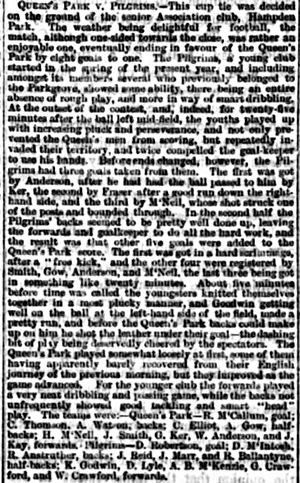Pilgrims F.C. (Glasgow) facts for kids
| Full name | Pilgrims Football Club | ||
|---|---|---|---|
| Founded | 1880 | ||
| Dissolved | 1886 | ||
| Ground | Copeland Park | ||
| Match Secretary | David M'Intosh | ||
| Hon Secretary | Frederick Franz | ||
|
|||
Pilgrims Football Club was a Scottish football team from Govan, which is now part of Glasgow. The club played during the 1800s.
Contents
Club History
The Pilgrims Football Club started in March 1880 with 40 members. In their first short season, they played two games and scored 7 goals while only letting in 2.
The club was an amateur team. This means their players did not get paid to play football. Other nearby amateur teams included Queen's Park, Battlefield, and Pollokshields Athletic. Sometimes, players from these four teams would even join together to play special exhibition games as a team called Glasgow Wanderers.
In 1880, many players from the Parkgrove club joined the Pilgrims. Parkgrove had to leave their home ground, Trinidad Park, so joining Pilgrims was a good move for their players.
Scottish Cup Adventures
The Pilgrims played in the Scottish Cup every year from 1880–81 to 1885–86. Their best performance was in their very first year.
In the first round, they beat Lancefield 4–2. S. Lyall scored all four goals for Pilgrims! The Lancefield goalkeeper, Boyd, played very well, saving many shots. In the second round, Pilgrims had their biggest Cup win ever, beating City 7–0. However, their journey ended in the third round when they lost 8–1 to Queen's Park.
After this strong start, the Pilgrims only won one more Scottish Cup game. This happened in the 1882–83 Scottish Cup when they beat Possilpark 6–0 in the first round.
In 1883, the Pilgrims took over another club called South Western. Both teams used the same home ground, Copeland Park. The Pilgrims name was more popular, even though South Western had more members (over 80 compared to Pilgrims' 46).
Later Years and End of the Club
In the 1884–85 season, the Pilgrims were still a well-known team. They were even invited to play in the opening game at Beresford Park, the new home ground for Ayr. Ayr won that match 3–1.
Near the end of that season, a player named Walter Lamont became the only Pilgrims player to play for his country. Walter was a left-winger who played for Scotland. He had an amazing first game, scoring the first goal in Scotland's 8–2 win against Ireland! However, he never played for Scotland again after that.
Around this time, many English clubs started paying their players, becoming "professional." Also, there were many amateur clubs in south Glasgow. The Pilgrims club slowly faded away. They did not pay their fees for the 1886–87 season, so the Scottish Football Association removed them from their list of member clubs.
Team Colours
When the club first started, their jerseys had 1-inch white and half-inch black hoops. They wore blue shorts and socks of any colour.
In 1881, they changed to jerseys with regular 1-inch black and white hoops. In 1883, they started wearing white shorts.
In 1884, perhaps to honour the South Western club they took over, the Pilgrims changed their jerseys again. They started wearing orange and black stripes, which were South Western's colours.
Home Grounds
The Pilgrims Football Club first played their home games at Middleton Park. After one season, they moved to Copeland Park.
When the Pilgrims club stopped playing, the Copeland Park ground was then used by a new club called St Peter's.
Notable Players
- Walter Lamont, the only Pilgrims player to play for the Scottish national team.


